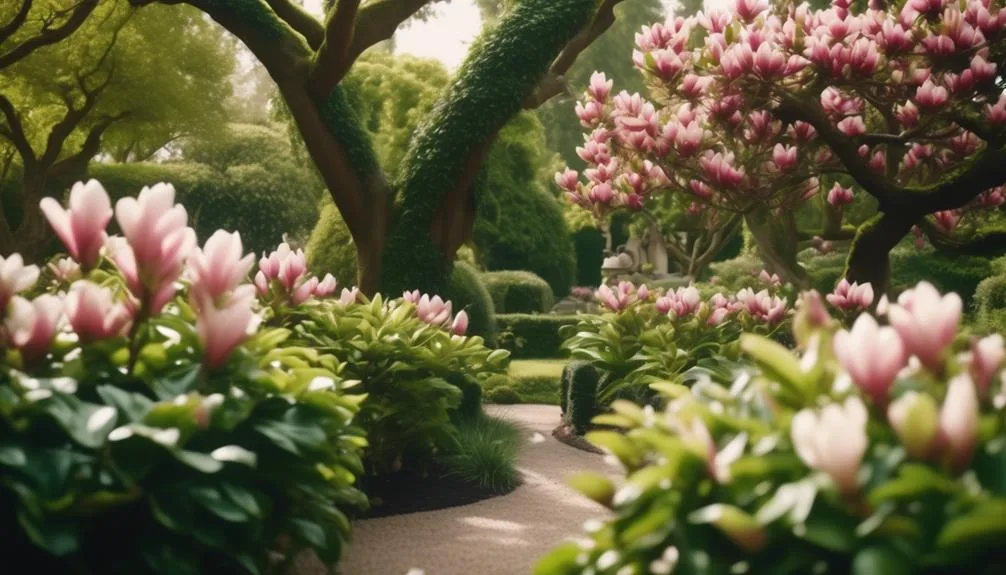Creating a stunning magnolia tree feature in your garden can be a fulfilling project. It involves careful planning, thoughtful selection, and ongoing care.
Picture the beauty of a saucer magnolia tree in full bloom, its delicate pink petals contrasting against the lush greenery.
But where do you start and how do you ensure success? Let's explore the steps to bring this vision to life and create a captivating magnolia tree feature that will enhance the beauty of your garden.
Choosing the Right Location
To ensure the optimal growth and beauty of your magnolia tree, you should carefully select a location that receives ample sunlight and offers well-draining soil. Finding optimal sunlight is crucial for the health of your magnolia tree. Look for a spot that gets at least six hours of direct sunlight daily.
When it comes to soil preparation, ensure that the soil is well-draining to prevent waterlogging, which can lead to root rot. Once you've found the perfect spot, consider the watering needs of your magnolia tree. While young trees may require more frequent watering, established trees generally have low to moderate watering needs.
Additionally, be mindful of potential obstacles such as nearby structures or trees that may cast unwanted shade or compete for resources. By carefully considering these factors, you can set the stage for a thriving and beautiful magnolia tree in your garden.
Selecting the Perfect Magnolia Tree
When selecting the perfect magnolia tree for your garden, consider the unique features and characteristics that will complement your landscape and climate. Here are four essential tips to guide you in your selection:
- Consider the Variety: Choose from a diverse range of magnolia tree varieties, each with its distinctive flower shape, size, and color.
- Evaluate Nursery Options: Visit reputable nurseries to explore a wide selection of healthy magnolia trees and seek advice from knowledgeable staff.
- Assess Soil Preparation: Ensure your garden soil is well-draining, slightly acidic, and rich in organic matter to provide an ideal environment for your magnolia tree to thrive.
- Climate Compatibility: Select a magnolia tree species that's well-suited to the climate of your region to promote healthy growth and abundant blooms.
Planting and Caring for Your Magnolia Tree
Consider adding a stunning magnolia tree to your garden to create a captivating focal point and enjoy its timeless beauty throughout the seasons.
When planting your magnolia tree, ensure the soil is well-drained and rich in organic matter. Dig a hole twice as wide as the root ball and mix in compost for soil preparation.
After planting, water the tree deeply and regularly, especially during dry spells. Fertilize the tree annually in early spring with a balanced fertilizer to promote healthy growth and vibrant blooms.
Keep an eye out for pests like scale and aphids, especially during the growing season, and promptly address any pest issues. Additionally, prevent diseases by ensuring good air circulation around the tree and promptly removing any diseased foliage.
With proper care, your magnolia tree will flourish and become a cherished feature in your garden.
Incorporating Complementary Plants and Features
As you cultivate the timeless beauty of your magnolia tree, envision enhancing its allure by seamlessly integrating complementary plants and features into your garden landscape.
- Companion plants: Select plants that bloom at different times of the year to ensure your garden remains vibrant and colorful throughout the seasons.
- Garden design: Incorporate elements like winding pathways, seating areas, and water features to create a harmonious and inviting garden space around your magnolia tree.
- Contrasting foliage: Choose plants with contrasting leaf shapes and colors to create visual interest and highlight the magnolia tree as the centerpiece of your garden.
- Attractive structures: Install trellises, arbors, or decorative fencing near the magnolia tree to add vertical interest and create a stunning backdrop for your garden.
Maintaining and Pruning Your Magnolia Tree
To ensure the health and beauty of your magnolia tree, regular maintenance and pruning are essential for promoting optimal growth and blossoming.
When it comes to pruning techniques, it's important to remove dead or damaged branches to encourage new growth and maintain the tree's shape. Make clean cuts just above a bud or branch junction to promote healing and prevent disease.
The best time for pruning a magnolia tree is immediately after it finishes flowering, typically in late spring or early summer.
Additionally, seasonal maintenance, such as providing adequate water and mulch, is crucial for the tree's overall well-being. Regularly inspect the tree for signs of pests or disease, and address any issues promptly.
Conclusion
Incorporate the perfect magnolia tree into your garden. Nurture it with care and complement it with other plants for a captivating oasis.
With ongoing maintenance, watch your garden flourish into a truly enchanting sanctuary.
Happy gardening!

My interest in trees started when I first saw the giant sequoias in Yosemite.
I was a teenager then, and I remember thinking, “I need to learn more about this.”
That moment stuck with me.
A few years later, I went on to study forestry at Michigan Tech.
Since graduating, I’ve worked in a mix of hands-on tree care and community education.
I’ve spent over ten years helping people understand how to plant, maintain, and protect the trees in their neighborhoods.
I don’t see trees as just part of the landscape.
They are living things that make a real difference in our daily lives.
